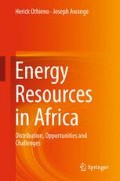Abstract
Traditionally, the countries that are referred to as North Africa are Egypt, Libya, Tunisia, Algeria, Morocco and Western Sahara. These are the Arab States in the African continent but a country like Sudan which has had long history of association with North Africa is often included as part of the region.
Access this chapter
Tax calculation will be finalised at checkout
Purchases are for personal use only
References
Arab Organization for Agricultural Development. (2012). Statistical book (Vol 32).
Brahim, F. B., Makni, J., & Bouri, S. (2013). Properties of geothermal resources in Kebilli region. Southwestern Tunisia, Environmental Earth Sciences, 69(2013), 885–897.
EIA. (2014). Key world energy statistics from 2006 to 2013.
Elamouria, M., & Ben Amara, F. (2008). Wind energy potential in Tunisia. Renewable Energy, 33(2008), 758–768.
Farouk, E. (2013). Egyptian renewable energy activities and strategy new and renewable energy authority, Egypt. Available on line http://www.unido.or.jp/download/NREA_Strategy_April_2013.pdf. Accessed Aug 2014.
Fekraoui, A. (2010). Geothermal activities in Algeria. In Proceedings of the 2010 World Geothermal Congress, Bali, Indonesia, April 25–29, 2010, paper No. 0117.
Hermann, S., Miketa, A., & Fichaux, N. (2014). Estimating the renewable energy potential in Africa, IRENA-KTH working paper. Abu Dhabi: International Renewable Energy Agency.
Idris, M. (2000). Geothermal evaluation of thermal fluids at Helwan Springs, Egypt. In Proceedings of the 2000 world geothermal congress, Kyushu-Tohoku, Japan, May 28–June 10, 2000.
Khellaf, A, Khadri, F., & Guezzane, S. (2002). Photovoltaic option in Algeria: Current action. In: Euro Mediterranean workshop on Euro-mediterranean renewable energies, European Commission’s INCO Program, Nicosia, Cyprus, May 18–21, 2002.
Lashin, A. (2013). A preliminary study on the potential of the geothermal resources around the Gulf of Suez, Egypt. Arab Journal of Geosciences 6, 2807–2828.
Lund, J. W., Freeston, D. H., & Boyd, T. L. (2011). Direct utilization of geothermal energy 2010 worldwide review. Geothermics, 40(2011), 159–180.
Mohamed, M. B. (2003). Geothermal resource development in agriculture in Kebili region, Southern Tunisia. Geothermics, 32, 505–511.
Mohamed, M. B. (2010). Geothermal Direct application and its development in Tunisia. In Proceedings of the world geothermal congress 2010, Bali, Indonesia, April 25–29 2010.
Mortensen, N. G. (2006). Wind Atlas for Egypt a national database for wind resource assessment and wind power planning. Risø National Laboratory MENAREC 3, Cairo, Egypt 12 June 2006.
Renewable Energy Authority of Libya (REAoL), National plan for developing The renewable energy in Libya (2013–2025) https://www.iea.org/media/workshops/Libya_RE_National_Plan.pdf. Accessed August 2014.
Saleh, I. (2006). Prospects of renewable energy in Libya. In R. Ramelli., O. M. Shalabiea, I., Saleh, & J. O. Stenflo (Eds.), Proceedings of the international symposium on solar physics and solar eclipses (SPSE), Libya, March 27–29 2006.
The wind power, http://www.thewindpower.net/country_africa_en.php. Accessed July 2014.
Trieb, F. (2005). Concentrating solar power for the Mediterranean region, final report, DLR&BMU, Stuttgart 2005. Also available online: http://www.dlr.de/tt/med-csp.
Zaher, M. A., & Ehara, S. (2009). Heat flow and geothermal resources in Egypt. Journal of the Geothermal Research Society Japan, 31, 155–166.
United Nations. (2014). UNEP Environment Questionnaire on Environment Statistics. Online: http://unstats.un.org/unsd/environment/municipalwaste.htm
Author information
Authors and Affiliations
Corresponding author
Rights and permissions
Copyright information
© 2016 Springer International Publishing Switzerland
About this chapter
Cite this chapter
Othieno, H., Awange, J. (2016). Energy Resources in Northern Africa. In: Energy Resources in Africa. Springer, Cham. https://doi.org/10.1007/978-3-319-25187-5_5
Download citation
DOI: https://doi.org/10.1007/978-3-319-25187-5_5
Published:
Publisher Name: Springer, Cham
Print ISBN: 978-3-319-25185-1
Online ISBN: 978-3-319-25187-5
eBook Packages: EnergyEnergy (R0)

